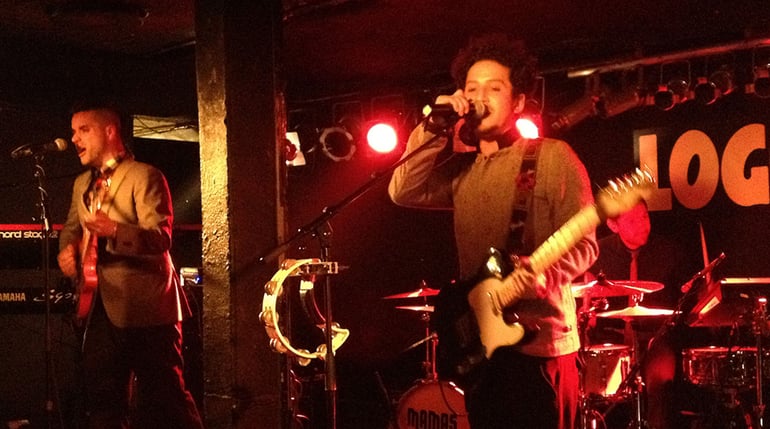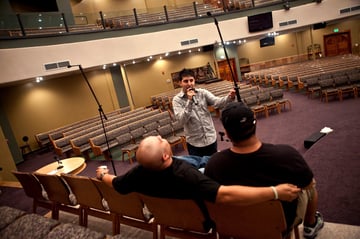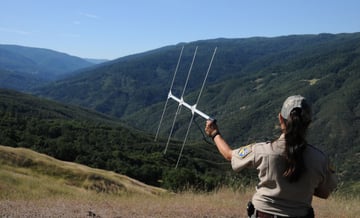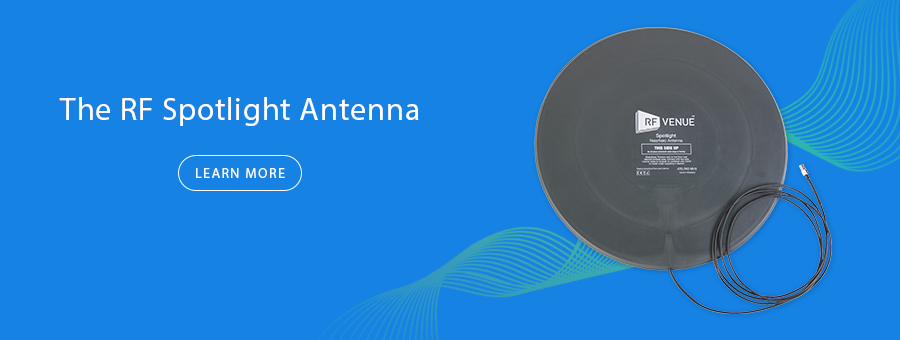- Products
- All Products
- RF PA Extension Kit
- Wireless Microphone Upgrade Packs
- In-Ear Monitor Upgrade Packs
- Wireless Microphone Antennas
- Wireless In-Ear Monitor Antennas
- Antenna Distribution for Microphones
- Antenna Combiners for In-Ear Monitors
- Multi-Zone Antenna Combiners
- Spectrum Tools
- Accessories, Cables and Parts
- Solutions by Venue
- Resources & Training
- Performance Tools
- About Us

Small venues offer an abundance of errant charms. Funky seating, graffitied bathrooms, folk art: they are the authentic backdrops to stages where real music is played.
Unfortunately, they also may offer a minefield of interference to the wireless audio user.
Whether you’re a traveling band that brings their own wireless kit, or an in-house engineer doing their best to maintain an honest, trouble-free venue, you should keep a close eye—and ear—out for these common and frustrating RF phenomena.
Amps and personal mixing equipment
The personal monitor mixers so popular with bands these days are notorious for dirty electrical components that kick out bad RF. Other common road gear like effects pedals and guitar/bass amplifiers can, either through malfunction or poor design, also be a source of radio interference. Since these devices are on the stage, they are in a good spot to interact with wireless transmitters and beltpack monitor receivers worn by performers.
Neon signs
Nothing beats a dive bar for late night jams. Gracing the walls, a garish display of defunct beer logos in kitschy neon tube. Neon tubes use high-voltage electricity to excite the atoms of noble gases sealed inside. Every neon sign has a transformer that steps line voltage up to as much as 15,000 volts. These transformers, especially old ones, are usually the problem. But occasionally electrodes in the sign may arc onto condensed beads of mercury or over to the edge of the tube, causing broadband RFI. Unplugging the sign will put a stop to the interference.
LED stage lights
Although you won’t find too many four-story video walls in small venues, LED lighting is just about everywhere, now. DMX controlled LED fixtures are very popular as multi-purpose effect kits that change colors and swivel around and other such trickery, but they can spew a ton of radio waves. Since theatrical LED lighting may be part of the show, it’s difficult to turn them completely off. Instead, a high gain directional antenna is often used to reject LED interference and focus on the performers.
Neighboring venues
In dense urban areas, or clusters of buildings/rooms common to contemporary churches and corporate campuses, it is not uncommon for wireless audio devices in use by other venues to interfere with their neighbors. The best thing to do, if possible, is reach out to your neighbors and trade frequencies to make sure you aren’t stepping on each other’s heels. Where this isn’t practical, another option is to use a neafield antenna like the RF Spotlight to block out incoming frequencies.
Intermods
We will wait for a future article to fully explain intermodulation. In short, intermodulation artifacts are unavoidable, unwanted radio frequencies that develop through the interaction of two or more transmitters. Proper setup of multi-channel systems must use a frequency coordination program to predict where intermodulation products will be. Professional Wireless’ IAS is a popular option, as is Clear Waves. Mac users can try Vantage by RF Venue.
Camera crews
Local news station stop by to cover the show? Look out. Camera crews are known for destroying carefully coordinated frequency sets. Not only do they carry their own wireless microphones, but their video links are often wireless as well. Handheld video monitors or camera connections back to the truck can gobble up enormous amounts of spectrum, and an increasingly common technology called cellular bonding, used to transmit live footage back to the studio, consumes every unlicensed band it can find.
Leaky power transformers on poles outside
Electrical grid transformers are responsible for squeezing a tremendous amount of electrical energy down into the 110/20 60Hz A/C that lets you watch TV. Many are heavy coils of wire soaking in a vat of inert oil. Sometimes, they “leak” RF energy as an unintentional byproduct of the voltage transformation. The RF from a sketchy transformer can be so strong it will penetrate venue walls after traveling a few hundred feet. Of course, if you do determine a power transformer is to blame, keep your distance.
WAPs and routers
WiFi WAPs and routers are only of concern when using 2.4 GHz wireless microphones. In some venues like hotels, they can be quite powerful and wreak havoc on your 2.4 system.
Mystery sources
If only we could cover every possible source of interference in one article, but we can’t. Anything that uses electricity has the potential to create harmful radio interference. Anything at all. Sometimes, when you have eliminated all of the usual suspects, the only thing left to do is try and physically track the stuff down. And we explain how to do that in this previous article.
Leading image courtesy Snoopsmaus
Alex Milne
Alex Milne was Product Marketing Manager and Digital Marketing Manager for RF Venue, and a writer for the RF Venue Blog, from 2014-2017. He is founder and CEO of Terraband, Inc., a networking and ICT infrastructure company based in Brooklyn, NY., and blogs on spectrum management, and other topics where technology,...
More from the blog

DISTRO4 - With Cascade
Five Wireless Mistakes Holding Church Techs Back From Great Audio
5 min read
| December 14, 2014
Read More

CP Beam Antenna
Hunting Down Interference
7 min read
| December 14, 2014
Read More

The Earth Speaks, and You Can Hear It with a Radio Receiver
3 min read
| December 14, 2014
Read More
Subscribe to email updates
Stay up-to-date on what's happening at this blog and get additional content about the benefits of subscribing.

